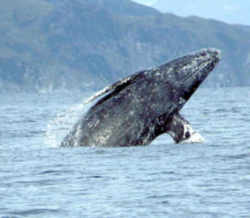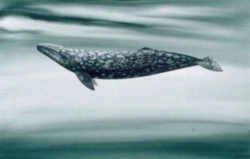
California Symbols
California State Marine Mammal
California Gray Whale

(Eschrichtius robustus)
Adopted on August 24, 1975.
The California gray whale, Eschrichtius robustus, was designated the State Marine Mammal on August 24, 1975.
Measuring 35 to 50 feet in length and around 20 to 40 tons in weight, the California gray whale (Eschrichtius robustus) is identified by
its mottled gray color and low hump in place of a dorsal fin. Gray whale feed mainly on small crustaceans along the ocean bottom in the western Bering
Sea where they spend the summer.
From December through February, the whales can be seen traveling southward in small groups along the California coast on their way to the bays and
lagoons of Baja California where mating occurs and the females calve. In March and April, they once again travel north following the shoreline. The
whales cover approximately 6,000 to 7,000 miles each way. It is believed that memory and vision aid them on their long migration.
California State Marine
Mammal:
California Gray Whale

The gray whale is
the only species in the baleen whale family Eschrichtiidae. Seen from above, its body tapers at both ends, and is a dark slate color that can appear
mottled gray. Generally, so many barnacles and whitish scars appear on older whales that the original slate color is almost obscured. The head is relatively
small and slopes downward from a pair of blowholes. The long mouth line bisects the head and curves slightly upward. The baleen plates are less than
0.5 meters (20 inches) long, yellowish to white with yellowish-white bristles. Two to five shallow grooves furrow the underside of the throat. The
gray whale has no dorsal fin, but a series of low round humps are present on the rear portion of the back. The spout is not very distinctive, rising
low and quickly, usually reaching a height of three meters (10 feet), but it may go as high as 6 meters (20 feet).
Size: The average size of a gray whale is approximately nine to 15 meters (30-50 feet) long, and it may weigh up to 32,000 kg (35 tons).
Natural History of the California Gray Whale
Gray whales spend the summer months in the Bering and Chukchi seas, and then leave for the breeding lagoons along western Baja California and off
southern Sonora and Sinaloa, Mexico. They follow the longest migration route of any mammal on Earth, traveling nearly 20,000 km (13,000 miles) round
trip. The southern migration begins in late September or early October. By December of most years, the first individuals pass along the California
coast, with peak numbers passing by in early January. After their stay in the lagoons of Baja California, the whales begin their northward passage,
starting in February and usually ending in late March. The last whales to travel north are mothers with young. This species is not considered very
social, though it is not uncommon to see groups of four or five whales traveling together. During migration, the whales typically travel in groups
of two of more individuals. They generally stay within 10 km (six miles) of the coastline. When near the shoreline or boats, gray whales will rise
vertically out of the water, just high enough to scan its surroundings. This behavior is called spyhopping and may last as long as 30 seconds. Occasionally,
gray whales breach- propel the body about halfway out of the water, then fall back with a big splash.
Gray whales obtain most of their food during the summer months in the Arctic. Their diet consists mainly of amphipods and other crustaceans, along with some mollusks and other invertebrates. The whale uses its tongue to create a strong oral suction to suck in food-rich ocean-floor sediment. Reversal of this oral suction allows the whale to force the sediment back out of the mouth trapping food items in its baleen plates. When in their southern breeding grounds, the whales typically fast, although they are known to feed on sardines.
California Law
The law designating the California gray whale as the official California state marine mammal is found in the California Government Code, Title 1, Division 2, Chapter 2.
CALIFORNIA GOVERNMENT CODE
TITLE 1. GENERAL
DIVISION 2. STATE SEAL, FLAG, AND EMBLEMS
CHAPTER 2. STATE FLAG AND EMBLEMS
SECTION 420-429.8
425.5 The California gray whale (Eschrichtius robustus) is the official State Marine Mammal.
Taxonomic Hierarchy: California Gray Whale
Kingdom: AnimaliaPhylum: Chordata
Class: Mammalia
Order: Cetartiodactyla
(unranked): Cetacea
(unranked): Mysticeti
Family: Eschrichtiidae
Genus: Eschrichtius - Gray, 1864
Species: E. robustus







